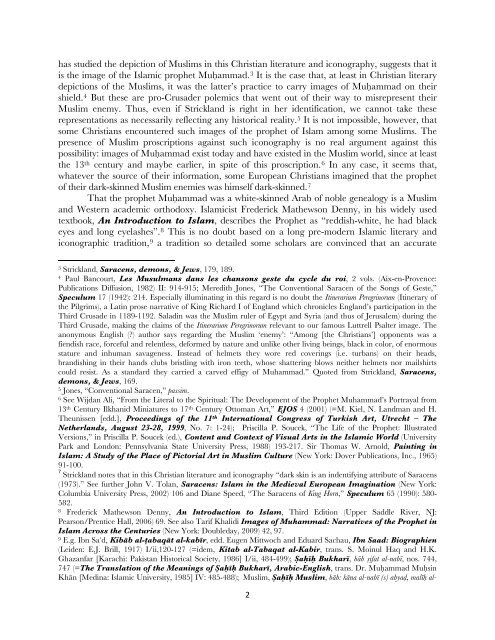“Anyone who says that the Prophet is black should be killed”: The ...
“Anyone who says that the Prophet is black should be killed”: The ...
“Anyone who says that the Prophet is black should be killed”: The ...
Create successful ePaper yourself
Turn your PDF publications into a flip-book with our unique Google optimized e-Paper software.
has studied <strong>the</strong> depiction of Muslims in th<strong>is</strong> Chr<strong>is</strong>tian literature and iconography, suggests <strong>that</strong> it<br />
<strong>is</strong> <strong>the</strong> image of <strong>the</strong> Islamic prophet MuÈammad. 3 It <strong>is</strong> <strong>the</strong> case <strong>that</strong>, at least in Chr<strong>is</strong>tian literary<br />
depictions of <strong>the</strong> Muslims, it was <strong>the</strong> latter’s practice to carry images of MuÈammad on <strong>the</strong>ir<br />
shield. 4 But <strong>the</strong>se are pro-Crusader polemics <strong>that</strong> went out of <strong>the</strong>ir way to m<strong>is</strong>represent <strong>the</strong>ir<br />
Muslim enemy. Thus, even if Strickland <strong>is</strong> right in her identification, we cannot take <strong>the</strong>se<br />
representations as necessarily reflecting any h<strong>is</strong>torical reality. 5 It <strong>is</strong> not impossible, however, <strong>that</strong><br />
some Chr<strong>is</strong>tians encountered such images of <strong>the</strong> prophet of Islam among some Muslims. <strong>The</strong><br />
presence of Muslim proscriptions against such iconography <strong>is</strong> no real argument against th<strong>is</strong><br />
possibility: images of MuÈammad ex<strong>is</strong>t today and have ex<strong>is</strong>ted in <strong>the</strong> Muslim world, since at least<br />
<strong>the</strong> 13th century and may<strong>be</strong> earlier, in spite of th<strong>is</strong> proscription. 6 In any case, it seems <strong>that</strong>,<br />
whatever <strong>the</strong> source of <strong>the</strong>ir information, some European Chr<strong>is</strong>tians imagined <strong>that</strong> <strong>the</strong> prophet<br />
of <strong>the</strong>ir dark-skinned Muslim enemies was himself dark-skinned. 7<br />
That <strong>the</strong> prophet MuÈammad was a white-skinned Arab of noble genealogy <strong>is</strong> a Muslim<br />
and Western academic orthodoxy. Islamic<strong>is</strong>t Frederick Ma<strong>the</strong>wson Denny, in h<strong>is</strong> widely used<br />
textbook, An Introduction to Islam, descri<strong>be</strong>s <strong>the</strong> <strong>Prophet</strong> as “redd<strong>is</strong>h-white, he had <strong>black</strong><br />
eyes and long eyelashes”. 8 Th<strong>is</strong> <strong>is</strong> no doubt based on a long pre-modern Islamic literary and<br />
iconographic tradition, 9 a tradition so detailed some scholars are convinced <strong>that</strong> an accurate<br />
3 Strickland, Saracens, demons, & Jews, 179, 189.<br />
4 Paul Bancourt, Les Musulmans dans les chansons geste du cycle du roi, 2 vols. (Aix-en-Provence:<br />
Publications Diffusion, 1982) II: 914-915; Meredith Jones, “<strong>The</strong> Conventional Saracen of <strong>the</strong> Songs of Geste,”<br />
Speculum 17 (1942): 214. Especially illuminating in th<strong>is</strong> regard <strong>is</strong> no doubt <strong>the</strong> Itinerarium Peregrinorum (Itinerary of<br />
<strong>the</strong> Pilgrims), a Latin prose narrative of King Richard I of England which chronicles England’s participation in <strong>the</strong><br />
Third Crusade in 1189-1192. Saladin was <strong>the</strong> Muslim ruler of Egypt and Syria (and thus of Jerusalem) during <strong>the</strong><br />
Third Crusade, making <strong>the</strong> claims of <strong>the</strong> Itinerarium Peregrinorum relevant to our famous Luttrell Psalter image. <strong>The</strong><br />
anonymous Engl<strong>is</strong>h (?) author <strong>says</strong> regarding <strong>the</strong> Muslim ‘enemy’: “Among [<strong>the</strong> Chr<strong>is</strong>tians’] opponents was a<br />
fiend<strong>is</strong>h race, forceful and relentless, deformed by nature and unlike o<strong>the</strong>r living <strong>be</strong>ings, <strong>black</strong> in color, of enormous<br />
stature and inhuman savageness. Instead of helmets <strong>the</strong>y wore red coverings (i.e. turbans) on <strong>the</strong>ir heads,<br />
brand<strong>is</strong>hing in <strong>the</strong>ir hands clubs br<strong>is</strong>tling with iron teeth, <strong>who</strong>se shattering blows nei<strong>the</strong>r helmets nor mailshirts<br />
could res<strong>is</strong>t. As a standard <strong>the</strong>y carried a carved effigy of Muhammad.” Quoted from Strickland, Saracens,<br />
demons, & Jews, 169.<br />
5 Jones, “Conventional Saracen,” passim.<br />
6 See Wijdan Ali, “From <strong>the</strong> Literal to <strong>the</strong> Spiritual: <strong>The</strong> Development of <strong>the</strong> <strong>Prophet</strong> Muhammad’s Portrayal from<br />
13th Century Ilkhanid Miniatures to 17th Century Ottoman Art,” EJOS 4 (2001) (=M. Kiel, N. Landman and H.<br />
<strong>The</strong>un<strong>is</strong>sen [edd.], Proceedings of <strong>the</strong> 11th International Congress of Turk<strong>is</strong>h Art, Utrecht – <strong>The</strong><br />
Ne<strong>the</strong>rlands, August 23-28, 1999, No. 7: 1-24); Pr<strong>is</strong>cilla P. Soucek, “<strong>The</strong> Life of <strong>the</strong> <strong>Prophet</strong>: Illustrated<br />
Versions,” in Pr<strong>is</strong>cilla P. Soucek (ed.), Content and Context of V<strong>is</strong>ual Arts in <strong>the</strong> Islamic World (University<br />
Park and London: Pennsylvania State University Press, 1988) 193-217. Sir Thomas W. Arnold, Painting in<br />
Islam: A Study of <strong>the</strong> Place of Pictorial Art in Muslim Culture (New York: Dover Publications, Inc., 1965)<br />
91-100.<br />
7<br />
Strickland notes <strong>that</strong> in th<strong>is</strong> Chr<strong>is</strong>tian literature and iconography “dark skin <strong>is</strong> an indentifying attribute of Saracens<br />
(1973).” See fur<strong>the</strong>r John V. Tolan, Saracens: Islam in <strong>the</strong> Medieval European Imagination (New York:<br />
Columbia University Press, 2002) 106 and Diane Speed, “<strong>The</strong> Saracens of King Horn,” Speculum 65 (1990): 580-<br />
582.<br />
8 Frederick Ma<strong>the</strong>wson Denny, An Introduction to Islam, Third Edition (Upper Saddle River, NJ:<br />
Pearson/Prentice Hall, 2006) 69. See also Tarif Khalidi Images of Muhammad: Narratives of <strong>the</strong> <strong>Prophet</strong> in<br />
Islam Across <strong>the</strong> Centuries (New York: Doubleday, 2009) 42, 97.<br />
9 E.g. Ibn Sa#d, Kib§b al-ãabaq§t al-kabÊr, edd. Eugen Mittwoch and Eduard Sachau, Ibn Saad: Biographien<br />
(Leiden: E.J. Brill, 1917) I/ii,120-127 (=idem, Kitab al-Tabaqat al-Kabir, trans. S. Moinul Haq and H.K.<br />
Ghazanfar [Karachi: Pak<strong>is</strong>tan H<strong>is</strong>torical Society, 1986] I/ii, 484-499); ‘aÈÊÈ BukharÊ, b§b ßifat al-nabÊ, nos. 744,<br />
747 (=<strong>The</strong> Translation of <strong>the</strong> Meanings of ‘aÈÊÈ BukharÊ, Arabic-Engl<strong>is</strong>h, trans. Dr. MuÈammad MuÈsin<br />
Kh§n [Medina: Islamic University, 1985] IV: 485-488); Muslim, ‘aÈÊÈ Muslim, b§b: k§na al-nabÊ (s) abya∙, malÊÈ al-<br />
2
















